Fish Info
RED DRUM (Sciaenops ocellatus)
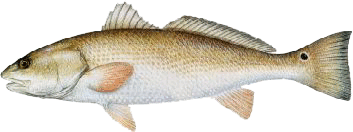
Description: chin without barbels; copper-bronze body, lighter shade in clear waters; one to many spots at base of tail (rarely no spots); mouth horizontal and opening downward; scales large.
Similar fish: black drum, Pogonias cromis.
Where found: juveniles are an INSHORE fish, migrating out of the estuaries at about 30 inches (4 years) and joining the spawning population OFFSHORE.
Size: common to 30 on the Gulf coast.
Limit: Five per person per day, 16 inches minimum total length, 27 inches maximum total length, No more than one over 27-inch maximum total length
Remarks: red drum are an INSHORE species until they attain roughly 30 inches (4 years), then migrate to join the NEAR SHORE population; spawning occurs from August to November in NEARSHORE waters; sudden cold snaps may kill red drum in shallow, INSHORE waters; feeds on crustaceans, fish, and mollusks; longevity to 20 years or more.
SPOTTED SEATROUT (Cynoscion nebulosus)
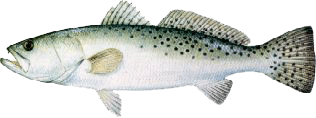
Description: dark gray or green above, with sky-blue tinges shading to silvery and white below; numerous distinct round black spots on back, extending to the dorsal fins and tail; black margin on posterior of tail; not barbels; no scales on the soft dorsal fin; one or two prominent canine teeth usually present at tip of upper jaw.
Similar fish: other seatrouts.
Where found: INSHORE and/or NEARSHORE over grass, sand, and sandy mud bottoms; move into slow moving or still, deep waters in cold weather.
Size: common to 4 pounds on west coast, larger on east coast.
Limit: Size limit: 13-20 inches total length, only two fish included within the daily creel limit can be greater than 20 inches total length. Daily Creel: 15-fish daily limit per angler. Charter Boat guides and crew will not be able to retain a creel limit while on a charter trip but may engage in fishing.
Remarks: matures during first or second year and spawns INSHORE from March through November, often in association with seagrass beds; lives mainly in estuaries and moves only short distances; adults feed mainly on shrimp and small fish; prefers water temperatures between 58 and 81 degrees F, and may be killed if trapped in shallow water during cold weather; longevity 8 to 10 years.
BLACK DRUM (Pogonias Cromis)
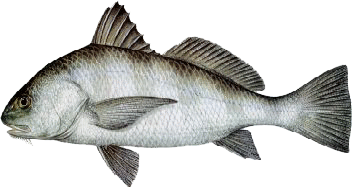
Description: high arched back; 10 to 14 pairs of chin barbels; gray or black colored body in adults; young have 4 to 6 vertical bars; has cobblestone-like teeth capable of crushing oysters; scales large.
Similar fish: the vertical bars on juvenile black drum are somewhat similar to those on sheepshead, Archosargus probatocephalus; spadefish, Chaetodipterus faber; red drum, Sciaenops ocellatus.
Where found:INSHORE fish common to bays and lagoons; bottom dweller often found around oyster beds; also OFFSHORE.
Size: common to 30 pounds.
Limit: Five per person per day, 16 inches minimum total length, 27 inches maximum total length, No more than one over 27-inch maximum total length
Remarks: largest member of the drum family; spawns NEARSHORE in winter and early spring; feeds on oysters, mussels, crabs, shrimp and occasionally fish; longevity to 35 or more years.
SHEEPSHEAD (Archosargus probatocephalus)
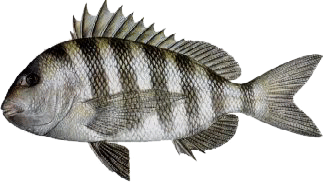
Description: basic silvery color, with 5 or 6 distinct vertical black bands on sides, not always the same on both sides; prominent teeth, including incisors, molars, and rounded grinders; no barbels on lower jaw; strong and sharp spines on dorsal and anal fins.
Similar fish: black drum, Pogonias cromis; Atlantic spadefish Chaetodipterus faber (black drum have barbels on lower jaw, sheepshead do not; vertical barring on sides of black drum and spadefish disappear as fish mature; spadefish have small, brush-like teeth.)
Where found: INSHORE species around oyster bars, seawalls and in tidal creeks; move NEARSHORE in late winter and early spring for spawning, gathering over debris, artificial reefs, and around navigation markers.
Size: INSHORE, 1 to 2 pounds, OFFSHORE, common to 8 pounds.
Remarks: feeds on mollusks and crustaceans such as fiddler crabs and barnacles; famed nibblers, prompting the saying that “anglers must strike just before they bite”.
COBIA (Rachycentron Canadum)

Description: long, slim fish with broad depressed head; lower jaw projects pass upper jaw; dark lateral stripe extends through eye to tail; first dorsal fin comprised of 7 to 9 free spines; when young, has conspicuous alternating black and white horizontal stripes.
Similar fish: remora, Echeneis naucrates
Where found: both INSHORE and NEAR SHORE inhabiting inlets, bays , and among mangroves; frequently seen around buoys, pilings, and wrecks.
Size: common to 30 pounds.
Remarks: spawns in spring and early summer; feeds on crabs, squid, and small fish.
GAG GROUPER (Mycteroperca microlepis)
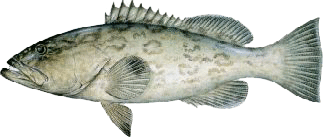
Description: color brownish grey in color with worm-like markings on sides; strong serrated spur at bottom margin of preopercle, less noticeable in large specimens; fins dark, with anal and caudal having white margin. Often confused with black grouper; tail of gag is slightly concave, black is square; gag has white margin on anal and caudal fins, black does not; under 10 pounds, gag’s spur on preopercle is distinctive, where black is gently rounded.
Similar fish:Black grouper; M. bonaci.
Where found: adults OFFSHORE over rocks and reefs; juveniles occur in seagrass beds INSHORE.
Size: common to 25 pounds.
Remarks: forms spawning aggregations in water no shallower than 120 feet in Middle Grounds area, January through March; current research to identify similar aggregations off Atlantic coast is ongoing. Young gags are predominantly female, transforming into males as they grow larger; feeds on fish
and squid.
JACK CREVALLE (Caranx hippos)
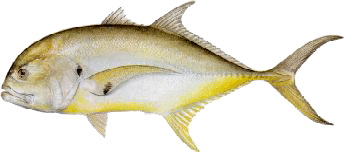
Description: color bluish-green to greenish-gold back and silvery or yellowish belly; soft dorsal and anal fins almost identical in size; prominent black spot on operculum (gill cover); black spot at the base of each pectoral fin; no scales on throat.
Similar fish:other Caranx.
Where found: common in both INSHORE waters and the open sea.
Size: common to 25 pounds.
Remarks: tolerates a wide range of salinities; schools corner a school of baitfish at the surface and feed with commotion that can be seen at great distances; feeds mainly on small fish; peak spawning occurs OFFSHORE from March through September.
FANTAIL MULLET (Mugil gyrans)
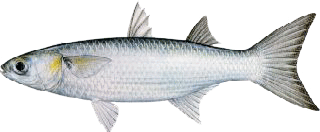
Description: color olive green with blue tints on back, shading to silvery sides, white below; anal and pelvic fins yellowish; dark blotch at base of pectoral fin; inverted V-shaped mouth; insertion of second dorsal over that of anal fin.
Similar fish: striped mullet, M. cephalus.
Where found: INSHORE, occurring along beaches in the fall.
Remarks: spawns in NEARSHORE or possibly INSHORE waters during spring and summer; juveniles occur INSHORE; feeds on algae, small crustaceans and detritus.
FLORIDA POMPANO (Trachinotus Carolinus)
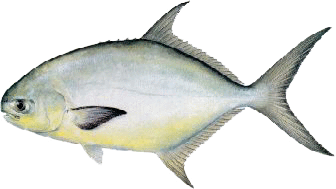
Description: greenish gray on back, shading to silvery sides; fish in dark waters showing gold on throat, pelvic, and anal fins; deep flattened body with small mouth; no scutes; 22 to 27 soft dorsal rays; 20 to 23 soft anal rays; origin of anal fin slightly behind origin of second dorsal.
Similar fish: permit, T. falcatus; palometa, T. goodei, The permit is deeper bodied; dorsal body profile not strongly angled at insertion of second dorsal fin; pompano rarely grow larger than 6 pounds, permit common to 40 pounds.
Where found: INSHORE and NEARSHORE waters, especially along sandy beaches, along oyster bars, and over grass beds, often in turbid water; may be found in water as deep as 130 feet.
Size: usually less than 3 pounds.
Remarks: spawns OFFSHORE between March and September; feeds on mollusks and crustaceans, especially sand fleas; local movements are influenced by the tide, and seasonal movements are influenced by temperature.
SPANISH MACKEREL (Scomberomorous maculatus)

Description: color of black green, shading to silver on sides, golden yellow irregular spots above and below lateral line; front of dorsal fin black; lateral line curves gently to base of tail.
Similar fish: cero, S. regalis; king mackerel, S. cavalla.
Where found: INSHORE, NEAR SHORE, and OFFSHORE, especially over deep grass beds and reefs; absent from north Florida waters in winter.
Size: average catch less than 2 pounds (20 inches).
Remarks: schooling fish that migrates northward in spring, returning to southerly waters when water temperatures drop below about 70 degree F; spawns OFFSHORE , spring through summer; feeds on small fish and squid.
TARPON (Megalops atlanticus)
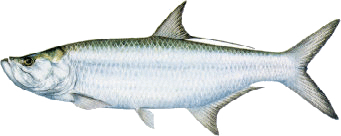
Description: last ray of dorsal fin extended into long filament; one dorsal fin; back dark blue to green or greenish black, shading into bright silver on the sides; may be brownish gold in estuarine waters; huge scales; mouth large and points upward.
Similar species: (as juveniles) ladyfish, Elops saurus.
Where found: primarily INSHORE fish, although adult fish spawn OFFSHORE where the ribbon-like larval stage of the fish can be found.
Size: most anglers catches 40 to 50 pounds
Remarks: slow grower, matures at 7 to 13 years of age; spawning occurs between May and September; female may lay more than 12 million eggs; can tolerate wide range of salinity; juveniles commonly found in freshwater; can breathe air at the surface; feeds mainly on fish and large crustaceans.
